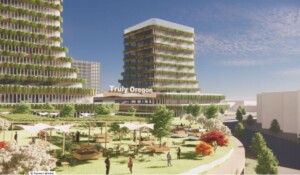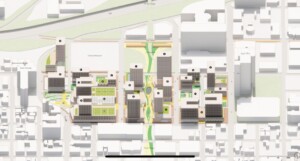2023 Plimpton-Poorvu Design Prize, Honorable Mention: “Truly, Oregon! Empower Lloyd Center, Portland, OR”

by Heejin Park (MAUD ’23), Terry Kim (MUP ’23), Aelin Shaoyu Li (MDes ’24), Claire Tham (MUP ’23), and Li Zhou (MDes ’23) — Recipients of the Plimpton-Poorvu Design Prize, Honorable Mention.
Lloyd Center is an existing 1.2 million square foot mall located on approximately 26 acres in the Lloyd District on the east side of Portland, Oregon. When it opened on August 1, 1960, it contained over 100 stores and was considered the largest open-air mall in the country. However, Lloyd Center has struggled in recent years. The mall lost four of its five anchor tenants. The pandemic has accelerated its decline, dropping occupancy to approximately 40%. Currently, the Lloyd Center represents one of the largest land assemblage opportunities in the broader Portland CBD. Existing zoning on the site allows for dense, urban development (225 ft height limit; 6:1 base FAR): approximately 10 million square feet of total development capacity. However, numerous encumbrances restrict development on the site, impact liquidity, and impair value.
One key characteristic of Oregon is its emphasis on outdoor activities and sports. Bringing in such culture, our project will encompass “Sportainment” as the core concept of the family amusement park, where visitors can use all the indoor attraction points for a flat-fee ticket. The supporting retail space will be signified by experiential zones where customers can try out apparel, sports gear, and outdoor products. Complementary outdoor venues will provide further entertainment to visitors and neighbors. Furthermore, the retail space will accommodate local chains, boutique restaurants, and cafes to inject vibrancy and create a truly Oregon character to the retail mix.
Construction costs and overhead and government expenses associated with the development will be incurred as a real estate development project. We had the privilege to discuss the potential land selling price with the current owner, the Urban Renaissance Group. and derived an estimated 115 million dollars for the 26-acre parcel (1.1 mil. sqft). Due to the nature of real estate development, the majority of the costs come from the building side. As an investment structure, we will utilize the Private Real Estate Investment Fund vehicle and aim to attract Asian institutional investors, including insurance firms, sovereign wealth firms, and multinational corporations. Specifically, we will target such entities in South Korea, Singapore, and Japan, which are top sources of cross-border investment in US real estate, injecting billions of dollars per single year. Per the 2020 article, they only look for 6% to 9%, so the low cost of capital of Asian investors will add much value to our financing structure.

